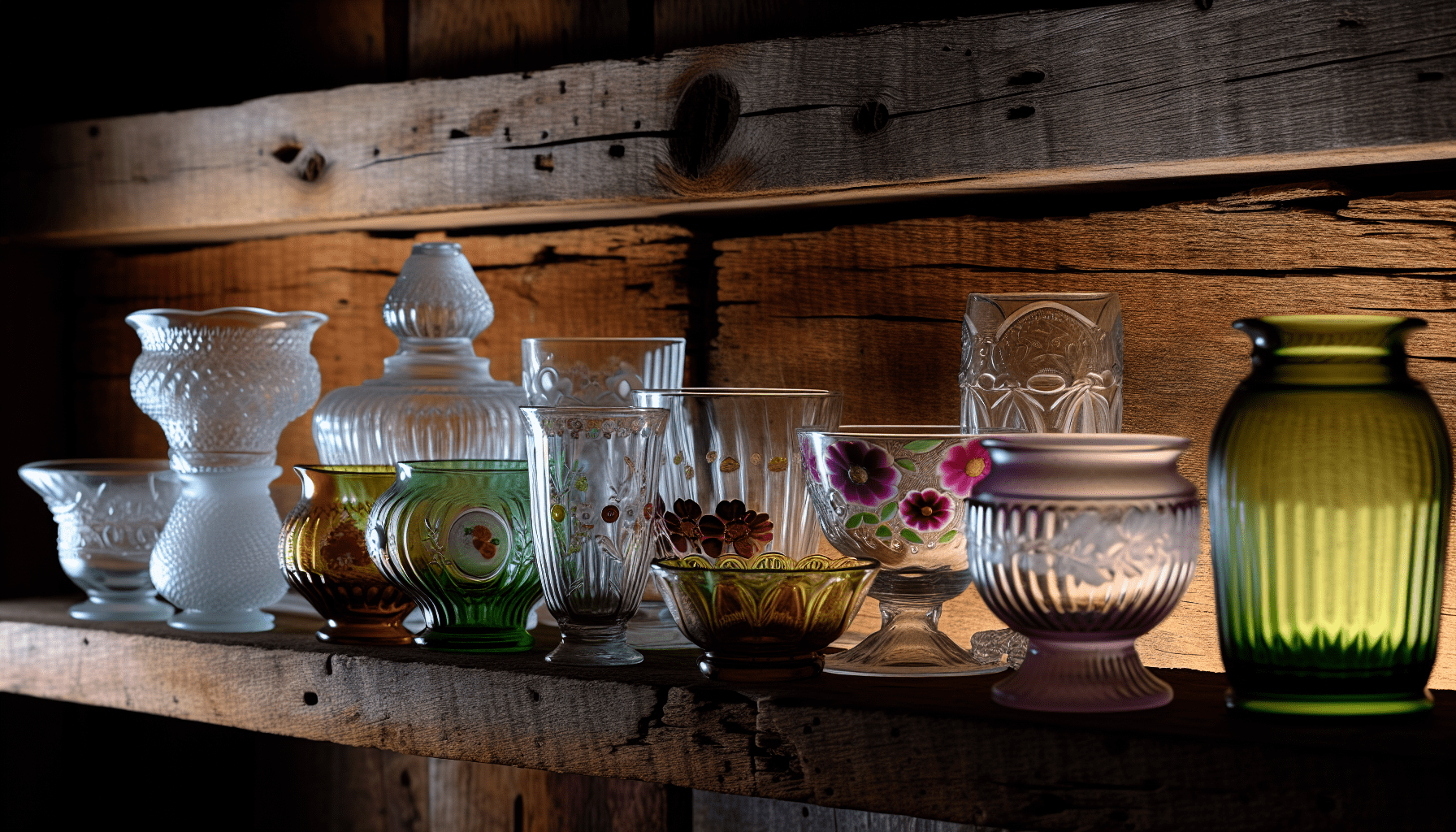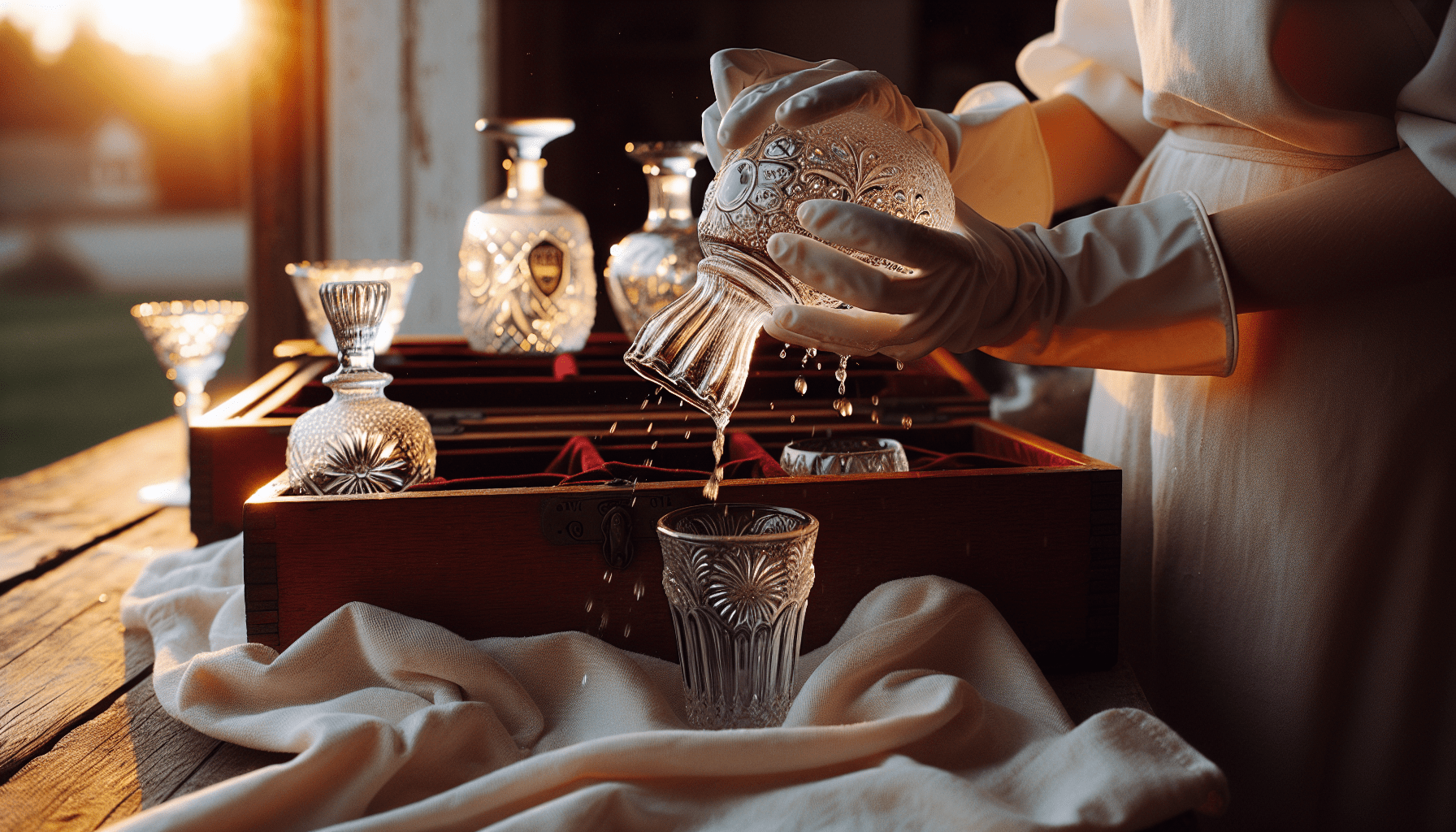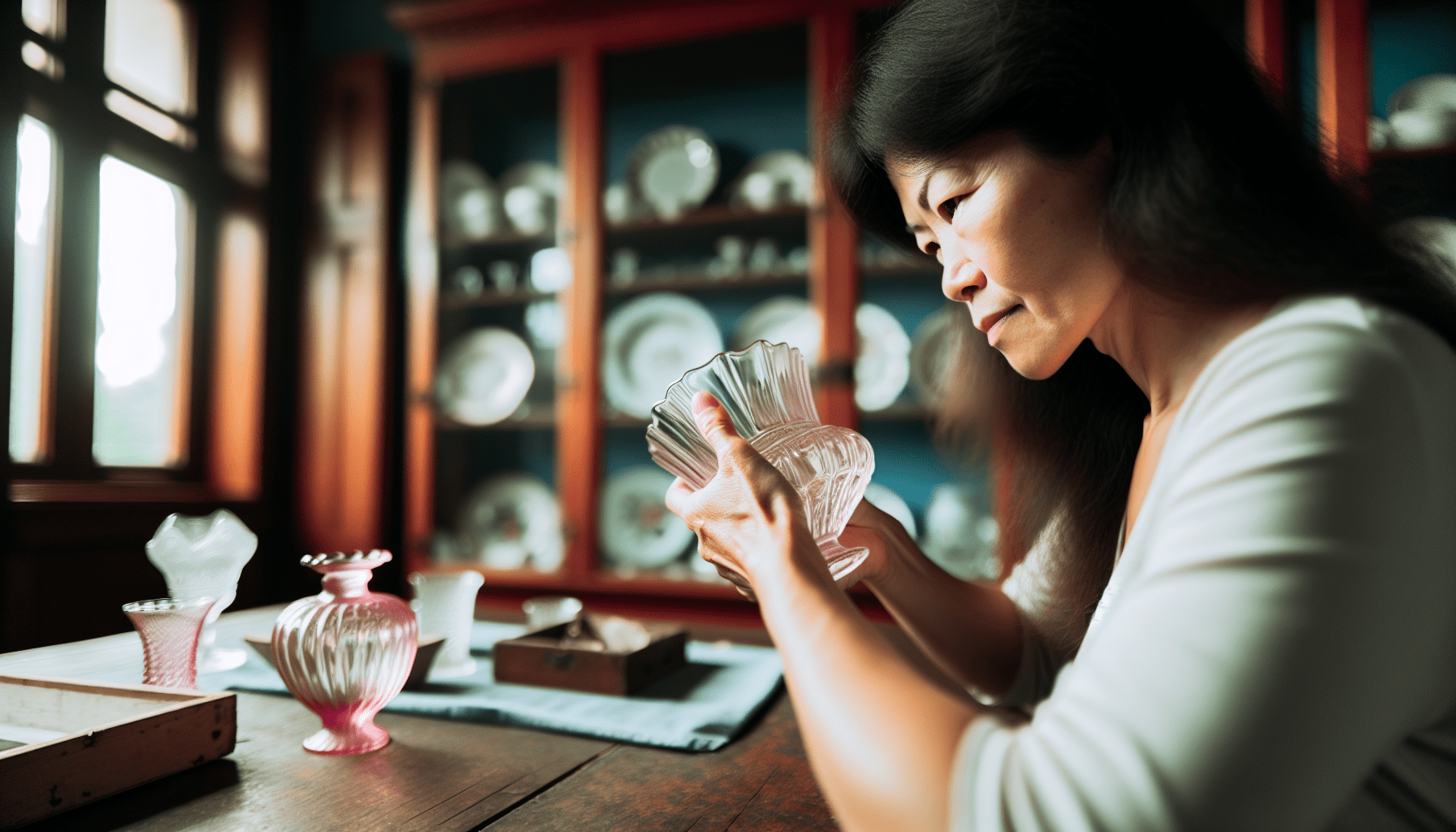Searching for information on American Sweetheart Depression Glass? From its scarcity to its charming patterns, this article will provide direct insights. We’ll dissect the reasons behind its collectibility, assist in identifying genuine pieces, and educate on accurate valuation. Let’s dive into the timeless allure of these Depression-era gems.
Key Takeaways
American Sweetheart Depression Glass, produced by Macbeth-Evans Glass Company from 1930 to 1936 during the Great Depression, is a delicate and intricately designed collectible prized for its rarity and historical significance.
The American Sweetheart pattern is known for its diverse color palette, including Monax, pink, cobalt blue, and ruby red, with pink being particularly popular for its warm, nostalgic charm and Monax noted for its opalescent shimmer.
Authentic American Sweetheart Depression Glass pieces have never been reproduced, and their value is affected by factors such as color rarity, minor production imperfections that authenticate their vintage origin, and overall condition, with significant damage greatly diminishing value.
The Allure of American Sweetheart Depression Glass

The Macbeth-Evans Glass Company produced the exquisite American Sweetheart pattern glassware from 1930 to 1936, a period marked by the economic hardships of the Great Depression. The design features an elaborate core motif of swags and scrolls, which is beautifully intricate, with additional ovals on cup sides and plate rims adorned with detailed paisleys and scrolls that underscore its delicate craftsmanship.
Due to their limited production during these tough years, pieces from this collection are scarce commodities today. Their rarity has fueled demand among collectors who consider them treasured finds in the antique glass selling market.
The Macbeth-Evans Glass Company
Founded in 1899, the Macbeth-Evans Glass Company came into existence by merging two entities: Thomas Evans & Co. and George A. Macbeth’s company, a legacy that continues to this day. The initial focus of Macbeth Co., was on producing items like lamp chimneys, reflectors, and lantern globes. It wasn’t long before their range expanded to include various other glass products. The early success of the company can be linked back to George A. Macbeth’s dedication to promoting his business through advertising as well as investing in research efforts – paving the way for his son who later took over as president.
1936 marked a pivotal year for the company with Corning Glass Works acquiring it which led to several changes within its operations structure ultimately leading up to its merger into World Kitchen in 1998.
National Depression Glass Association
The National Depression Glass Association (NDGA) plays a crucial role in preserving the history of Depression-era glass by carefully chronicling different patterns and their historical importance. Among these, the NDGA recognizes the American Sweetheart pattern for its distinctive design and impact on collectible glassware from that time period. Experts affiliated with the NDGA, including Joyce E. Krupey, have pinpointed patterns like American Sweetheart, Cameo, Mayfair, Princess, and Royal Lace as central to understanding the story of Depression glass history.
Color Palette and Patterns

The American Sweetheart Depression Glass is highly sought after for its elaborate designs and rich array of colors. The series featured production in several hues, including:
Monax, a translucent white
An inviting shade of pink
A vibrant ruby red
A striking cobalt blue
Clear crystal
There were pieces made in beige translucent Cremax and also Monax with an edge trim.
Pink: The Most Popular Color
American Sweetheart glassware is distinguished by its authentic baby pink shade, devoid of any orange shades. Its gentle and romantic pink color not only brings a warm and nostalgic atmosphere but also increases its value as a collectible item due to this endearing quality.
The appeal of the American Sweetheart collection, from luncheon plates to sugar bowls, is in its unique power to evoke memories of a time marked by both grace and endurance with every piece’s iconic soft pink hue.
Cobalt Blue and Ruby Red
Less prevalent than the pink varieties, cobalt blue items of American Sweetheart depression glass are especially prized by collectors for their scarcity. The lack of data regarding ruby red pieces in the collection suggests that they may be extremely rare or perhaps not even part of it at all. This element of rarity and enigma surrounding these less common colors enhances their desirability among aficionados seeking to add a touch of uniqueness to their assortment.
Translucent White (Monax)
The American Sweetheart pattern is renowned for its use of Monax, a translucent white glass that exhibits an opalescent sheen with subtle blue tinges at the edges. This lends a whimsical charm to the finely crafted pieces, which belie their robust nature with their ethereal visual quality. The bowls crafted in this style balance strength and fragility, presenting an unexpectedly resilient form.
Monax creations are highly sought after due to this unique combination of sturdy composition and graceful design. Their capacity to withstand wear while maintaining such exquisite delicacy makes them treasured components among collectors.
Tableware Essentials

The pattern known as American Sweetheart provides a comprehensive collection of tableware pieces, which elevates its adaptability and charm for both daily use and festive events.
Plates and Bowls
Plates and bowls from the American Sweetheart pattern are easily recognized by their soft scalloped edges adorned with classic floral motifs. This collection showcases a broad spectrum of styles reflective of its richly varied design elements.
Integral to this set are cups and saucers, which feature detailed patterns that beautifully coordinate with the plates and bowls, enhancing the overall appeal of the collection.
Salt and Sugar Containers
Salt and sugar receptacles from the American Sweetheart collection serve not just practical functions, but also capture the unique allure of their time period. Adorned with the signature American Sweetheart designs featuring elaborate lattice work and botanical motifs, these vessels represent a harmonious marriage of utility and artistic design.
These containers’ intricate decorations ingeniously concealed any potential signs of everyday kitchen usage, thereby enhancing their desirability.
Tumblers and Other Glassware
The American Sweetheart pattern, while featuring tumblers that are scarce and thus prized by collectors at a premium price, also offers an assortment of glassware pieces that are more budget-friendly. This collection includes:
luncheon plates
salad plates
cups
saucers
Such variety ensures the accessibility of the American Sweetheart series to a wider range of enthusiasts. Even so, uncommon components such as lids for sugar bowls can fetch steep prices, reflecting the diverse pricing spectrum present within this array of collectibles.
Caring for Your American Sweetheart Collection

Maintaining the elegance and worth of your collection of American Sweetheart Depression Glass requires meticulous attention to its care and storage. Each phase is crucial, from the methods you employ to cleanse these fragile items, to their storage solutions, down to showcasing them for admiration—ensuring your assemblage endures through time.
Cleaning and Storage
It is advisable to hand clean the American Sweetheart Depression Glass in order to avoid issues such as cloudiness or deterioration of painted or metallic detailing, which can result from dishwasher use. To safeguard your collection during cleaning, lay a towel at the bottom of the sink for padding and then make sure to dry each item with a linen towel. This helps ward off any water spot formation.
Distinguishing whether cloudiness on an article is due to irreversible harm or merely water staining is crucial in upholding the value of your assortment.
Displaying Your Collection
Designing an exhibition for your cherished American Sweetheart Depression Glass collection is truly a creative pursuit. Whether you’re accentuating the plates’ translucent quality with a tablescape aligned in hues or incorporating thematic ornaments, countless innovative methods exist to magnify the allure of your showcase.
To preserve and spotlight your assemblage on open shelving units, utilize museum putty for stability while employing gentle, diffuse lighting to avoid harsh reflections and glare that could detract from their beauty. Strategically blending antique treasures with contemporary elements and categorizing them by type or hue not only elevates their aesthetic charm but also conveys orderliness and ensures security for each piece within the display.
Collecting and Valuing American Sweetheart Depression Glass

Setting out to acquire American Sweetheart Depression Glass is an exciting endeavor. You’ll find these cherished items through a range of sources, including professional dealers, neighborhood garage sales, auction houses, and digital platforms. It’s important to recognize that the worth of these collectibles hinges greatly on their scarcity and popularity – with full collections often being especially sought after and thus expensive.
Identifying Authentic Pieces
All existing pieces of American Sweetheart Depression Glass are authentic originals, as there have never been any reproductions manufactured. These vintage items commonly exhibit bubbles, mold imperfections, and variations in color which reflect the mass production techniques of that time period. Authentic articles will often reveal wear from handling and distinct seams on the glass — traits not found in nonexistent copies.
Understanding these genuine features is beneficial for collectors to discern true American Sweetheart pieces from unlikely imitation products.
Determining Value
The worth of American Sweetheart Glass items is determined by a number of elements, including:
The hue: Items in pink, which were more abundantly produced, tend to carry higher price tags for certain articles. Pieces in monax and particularly those in ruby red are highly sought after due to their scarcity—ruby red being the most valuable.
Manufacturing flaws: Common irregularities like air bubbles or slight deviations in color do not lessen an item’s value. Rather, they can lend authenticity to its historic usage and importance.
Overall condition: Slight issues with the item’s state often don’t reduce its worth.
These aspects should be kept in mind when assessing the monetary value of pieces from the American Sweetheart Glass collection.
Nevertheless, severe damage such as ‘sick glass’, indicating harm from a dishwasher’s heat and detergents, or cracks that jeopardize the integrity of an item, can lead to a significant devaluation.
Summary
The charm of American Sweetheart Depression Glass is captured in its finely wrought designs, diverse shades including pink and cobalt blue, and the rich history it represents. Pieces like the soft-hued luncheon plates, Monax bowls, or striking cobalt blue tumblers each narrate a tale of enduring grace amidst challenging times. Ensuring your collection remains intact and grows in value hinges on proper maintenance as well as expert identification and appraisal.
In drawing our exploration of American Sweetheart Depression Glass to a close, let us not forget that these objects are more than mere collectibles. They are indeed physical remnants from a past epoch—emblems of endurance during an era rife with hardship—and represent the indomitable capacity for humans to forge splendor even when confronted with difficulty.
Frequently Asked Questions
Who made American Sweetheart Depression glass?
From 1930 to 1936, the MacBeth-Evans Glass Company manufactured the delicate Monax glass known as American Sweetheart Depression glass.
How do I know if my Depression glass is valuable?
Depression glass, which holds considerable value today, frequently encompasses scarce hues and designs from the period of the Great Depression. Such pieces were produced in limited runs and are now potentially worth a significant sum because their scarcity has increased over time.
Colors and patterns that were made in small quantities during that era tend to be deemed more rare and thus carry greater value for collectors.
Is Depression glass worth any money?
Indeed, the value of Depression glass can be quite substantial. Certain scarce patterns and hues have been known to command prices ranging from several hundred to thousands of dollars. The scarcity of a pattern coupled with its color often dictates how much it is coveted, leading some pieces to become extremely desirable collector’s items.
Do people still collect Depression glass?
Yes, Depression glass is still widely collected and many patterns are still easily available at reasonable prices.
When was Macbeth-Evans Petalware made?
Initially produced in crystal and pink colors, the Petalware line by Macbeth-Evans debuted between 1930 and the 1940s as one of the company’s earliest tableware patterns.

